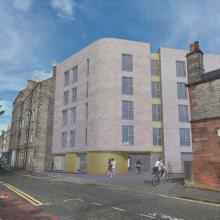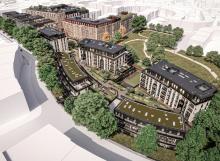
Councillors on the Development Management Sub-Committee today unanimously rejected officials’ recommendations and turned down applications to build 3–5-storey purpose built student accommodation on Eyre Place/Eyre Place Lane, providing 139 studio units and amenity space (23/04048/FUL); and seven adjacent townhouses (23/0404766/FUL).
The first of these was rejected on grounds of polices DES 1, DES 4, DES 5 and NPF 14. The second failed on grounds of policies HOU 3a, Des 2 and NPF 14. Definitions of these terms can be found here.
Deputations
Deputations against the proposal reflected views of 460 objectors. All speakers stated that they were not opposed to the principle of purpose built student housing on this site. Some locals said they would prefer family housing here but accepted student neighbours as part of the community.
New Town & Broughton Community Council has been involved in assessing plans for this site since the original pre-application consultation in 2021. It made a detailed objection to the subsequent application which was later turned down on appeal by the Scottish Reporter. Its objections to the current proposal included:
- Insufficient reduction in height
- Overbearing and unsympathetic form, height and massing
- Reduced sense of place and intimacy
- Negative impact on neighbours’ residential amenity, for example in terms of daylight and sunlight on Rodney Street tenements and their shared open space
- The developers’ limited engagement with locals.
As well as baulking at the proposal’s ‘monolithic’ proportions, The Eyre Place Lane Owners Association questioned the reduction of road space on the lane, suggesting it would add to parking pressure here and reduce the safety and access requirements of vehicles serving the Yard. The development would negatively affect the character of the area, and would provide insufficient high-quality indoor and outdoor amenity space for student residents.
Rodney Street residents focused on the negative impact on levels of sunlight and daylight for them. They said potential noise and loss of privacy from roof terraces was a material planning consideration affecting around 150 neighbours.
Ward Councillors Bandel, Mitchell and Nicolson spoke in support of objectors, some arguing that such uses of the area were disappointing given Edinburgh’s lack of affordable housing and housing emergency. Cllr Nicolson said she had received no comments from locals in support of the proposal.
Defending the proposal
A planning consultant and architect defended the latest application, saying it had accurately and sufficiently addressed the Reporter’s comments in an earlier appeal determination.
They disputed doubts about daylighting/sunlighting reports and said comparison of the scheme with a recently rejected PBSA application on Dunedin Street was inappropriate. They insisted student studios were of sufficient size and insisted that noise from roof terraces would not be a problem in carefully managed accommodation.
Sub-Committee concerns
Members of the DMS voiced various misgivings about the proposal, including:
- Whether amenity spaces in the PBSA could be guaranteed as such in perpetuity. They could not.
- Whether the student amenity space was of good enough quality – most thought too much was outside, enjoyed too little light, and was likely to be unpleasant to use especially in a Scottish winter.
- Whether studio units were an acceptable alternative to cluster accommodation in encouraging communal living and avoiding student isolation.
- Whether 50% of the site here was proposed as housing, as required. Should the site boundary area or developable site area be considered in this regard, and were accurate floor areas available for this purpose. A fog descended.
- Negative effect on neighbourhood character and urban grain.
- Serious detriment to neighbours’ amenity.
- Whether the revised application adequately met the Reporter’s earlier concerns.
In rejecting both proposals, councillors urged the developer to better solicit local knowledge and aspirations in future, and to follow more closely the Council's policy guidelines. They reasserted that neighbours were not opposed to the principle of development on this site or to the presence of students.
The lengthy hearing will be available to view shortly on the Council’s webcast archive.
For an update on this story, see Issue 336 (published on 1 February 2024).



